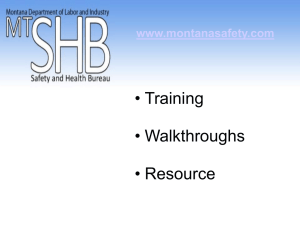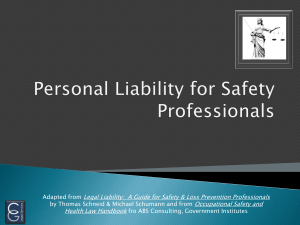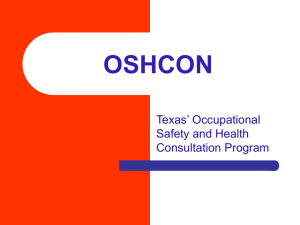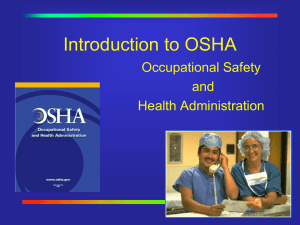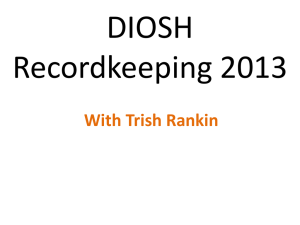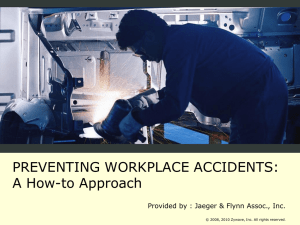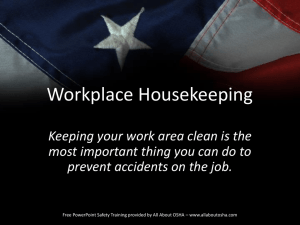OSHA Safety Guidelines for Animal Shelters
advertisement
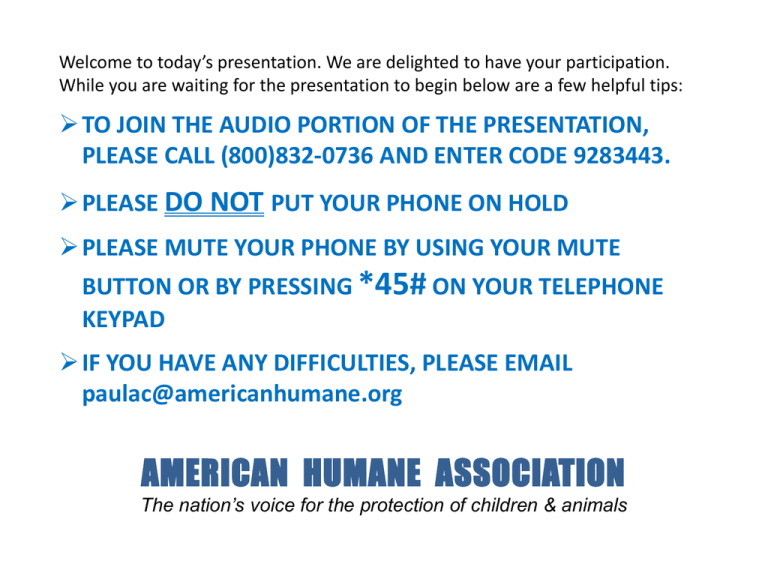
Welcome to today’s presentation. We are delighted to have your participation. While you are waiting for the presentation to begin below are a few helpful tips: TO JOIN THE AUDIO PORTION OF THE PRESENTATION, PLEASE CALL (800)832-0736 AND ENTER CODE 9283443. PLEASE DO NOT PUT YOUR PHONE ON HOLD PLEASE MUTE YOUR PHONE BY USING YOUR MUTE BUTTON OR BY PRESSING *45# ON YOUR TELEPHONE KEYPAD IF YOU HAVE ANY DIFFICULTIES, PLEASE EMAIL paulac@americanhumane.org AMERICAN HUMANE ASSOCIATION The nation’s voice for the protection of children & animals What is OSHA? The Occupational Safety and Health Administration is an agency of the U.S. Department of Labor created under the Occupational Safety and Health Act of 1970. OSHA’s mission is to prevent work-related injuries, illnesses and deaths by issuing and enforcing federal standards for workplace safety. All OSHA standards and guidelines can be found at www.osha.gov Why should I worry about OSHA? • Keep employees safe on the job • It’s the law • Reduce absenteeism due to work-related injuries or illnesses • Reduce worker’s comp claims and insurance costs • Decrease the likelihood of OSHA inspections, citations and fines State OSHA’s States with approved plans covering both public and private sectors: • • • • • • • • • • • • • • • • • • • • • • Alaska Arizona California Hawaii Indiana Iowa Kentucky Maryland Michigan Minnesota Nevada New Mexico North Carolina Oregon Puerto Rico South Carolina Tennessee Utah Vermont Virginia Washington Wyoming States with approved plans covering the public sector only: • • • • Connecticut New Jersey New York Virgin Islands States with unapproved plans: • Ohio New Mexico Occupational Health & Safety Bureau Your state plan can be found here: http://www.nmenv.state.nm.us/Ohsb_Website/ StatePlan/ OSHA’s General Duty Clause • Some of the most critical safety issues in shelters are not specifically addressed by any OSHA standard, but they do fall under the “General Duty Clause” • The General Duty Clause requires an employer to “furnish to each of his employees employment and a place of employment which are free from recognized hazards that are causing or are likely to cause death or serious physical harm to his employees” Create a Safety Manual Create a Safety Manual • Not required by OSHA • Best means of organizing all safety related information in one place • Separate from your general policies and procedures manual • Primary means of communicating and enforcing your shelter’s safety policies and procedures • Every employee should receive a copy upon hire • Maintain a copy in an easily accessible location, such as the staff break room Create a Safety Manual • • • • • • • • Develop an outline Address one topic at a time Begin with the most serious safety issues Involve your staff Create a written policy Staff training Implementation Enforcement Perform a Hazard Assessment • Fill out a Work Hazard Assessment Form for each area and task • Interview and observe staff • Consult MSDS’s for tasks that involve use of chemicals • Make changes or adjustments to improve workplace safety • Engineering controls • Procedural Controls • Use of PPE only when engineering or procedural controls are not possible Know Your Employer Rights • Implement and enforce safety rules in the workplace • Be present or designate a representative be present during any inspection or investigation by OSHA • Require that an OSHA compliance officer obtain a search warrant before entering or inspecting the business • Request that an inspection be postponed to a more convenient time • Maintain confidentiality of trade secrets Know Your Employer Rights • Consult an attorney before, during or after an inspection and before responding to any inquiry • View any complaint that has been alleged against the business • Require that employees be interviewed at a time that does not unreasonably impact their job duties • Appeal findings or citations issued by OSHA Know Your Employer Responsibilities • Provide a workplace free from recognized or unnecessary hazards • Implement and enforce safety rules and communicate them to employees in a clear manner • Provide all required PPE and adequate training for its use • Provide safety training to all employees on the potential hazards associated with their jobs and the steps necessary to perform their jobs safely Know Your Employees’ Rights • • • • • Workplace free from recognized hazards Be informed of their rights under the OSH Act Be informed of known hazards Be trained to safely perform their job Be provided with and instructed on the use of all required PPE • View and receive copies of all applicable OSHA standards Know Your Employees’ Rights • Have access to all illness, injury and exposure records maintained as part of the business • Be present in the workplace when safety monitoring is performed • File a complaint with their employer and/or OSHA when a hazard requires correction • Speak to an OSHA compliance officer privately during an inspection Know Your Employees’ Responsibilities • • • • • • Read the OSHA poster Comply with all applicable OSHA Standards Follow all employer safety and health rules Use required PPE Report any hazardous conditions to their employer Report any job-related injury or illness to their employer promptly • Cooperate with an OSHA compliance officer during an inspection Required Postings OSHA Poster 3165 OSHA Form 300A Hazard Warning Signs Exit Signs Other Required Postings • • • • Notices of OSHA inspections OSHA citations Written Hazard Communication Plan Written Fire Prevention and Emergency Response Plan Staff Training Staff Training • Employees must be trained before they are exposed to a hazard • Safety training must be documented • Read shelter safety manual before starting • Interactive training with manager Required Training • • • • • • • • • • General Duty Clause Employee’s rights and responsibilities Fire prevention and emergency response plan Noise exposure Ionizing radiation PPE Signs Medical services and first aid Portable fire extinguishers Hazard communication plan Multi-Employer Workplaces Multi-Site Workplaces Independent Contractors • OSHA requires that you assume the role of employer • Must undergo the same safety training and follow the same rules as you regular employees Volunteers • NOT covered by OSHA • Not required to report injuries, require PPE or provide safety training • Volunteers that are adequately trained in safe animal handling and use of chemicals are more likely to have a positive experience Work-Related Injuries and Illnesses Reporting of Work-Related Injuries and Illnesses • • • • • Death Loss of consciousness Fractured bone Punctured eardrum Chronic or irreversible disease • At least one day of missed work • Restriction of abilities or duties • Needle stick contaminated with human blood • Removed from the job for medical reasons listed under the OSHA health standard • Medical treatment other than first aid What is considered first aid? • Non-prescription medications • Cleaning, flushing, soaking a superficial wound • Wound coverings • Hot or cold therapy • Non-rigid means of support • Eye patches • Irrigation to remove foreign bodies in the eye • Irrigation, tweezers to remove foreign bodies from other areas • Finger guards • Massage • Tetanus vaccines • Drinking fluids to relieve heat stress OSHA Form 301 OSHA Form 300 OSHA Form 300A Record Maintenance • Shelters are NOT required to report work-related injuries or illnesses to OSHA unless they involve a death, work-place violence or hospitalization of five or more employees • Records must be maintained for 5 years • Records must be readily available for inspection by authorized state or federal OSHA officials • Employees and former employees are permitted to access the Log (Form 300) and Summary (Form 300A) only Personal Protective Equipment Personal Protective Equipment • PPE is NOT optional!!!!!!!!!!! • Maintain adequate quantities and appropriate sizes • Allow staff to choose PPE • Maintain in useable and sanitary condition Noise Hazards • OSHA requires a hearing conservation program when employees are exposed to noise levels above 85 dB based on an 8 hour time-weighted average (TWA) • Most animal shelters have unacceptable noise levels in dog kennel areas • Hearing protection required!!! Noise Hazards Hazard Communication Standard • Also known as the “Right to Know Law” • When employees are required to be exposed to a hazardous chemical, they have a right to be informed of the hazard, to be able to identify the hazard and know how to take protective measures to minimize their exposure • Requires every business that handles, stores or uses potentially hazardous chemicals to have a written plan for informing workers of the safety information • Applies to all chemicals on the premises Hazard Communication Standard Has five specific requirements: 1. The plan must be in writing 2. A complete list of all hazardous chemicals must be maintained at all times 3. A Material Safety Data Sheet (MSDS) must be maintained for each chemical on the list 4. All containers of hazardous chemicals must be properly labeled 5. All employees must be trained on the hazards and safety aspects of each chemical Written Hazard Communication Plan Must include the following: 1. Introduction stating the purpose of the plan 2. Name and contact information for the person(s) designated to handle safety issues 3. Description of the identification system used to label hazardous chemicals along with a sample label 4. Location of the MSDS binder and the method by which the sheets are filed 5. Detailed staff training information, including scheduling, materials used, objectives and person(s) responsible for conducting the training Hazardous Materials List • With very few exceptions, the list must include all products that are in liquid or powdered form • Products with the same formulation, but of different brand names, must be listed as separate products • Products of the same brand, but with different formulations, must be listed as separate products • Create the list by going room by room • Throw out old or donated products that are not used • Maintain list in a spreadsheet and sort alphabetically • A copy of the list should be placed in the front of your MSDS binder Hazardous Materials List Exceptions include the following: • Medications in solid form, not including capsules, gels, powders or crushed tablets • Food and nutritional products, including KMR, IV fluids and liquid vitamins • Drugs or cosmetics intended for personal consumption by employees • Articles that contain hazardous materials, such as thermometers, pens and autoclave tape • Any common consumer product when it is used in the same manner as a normal consumer would use it Material Safety Data Sheets Material Safety Data Sheets • You must have an MSDS for every product on your Hazardous Materials List • Obtain online from manufacturer’s website or call and request by phone – you must have hard copies • Must be filed in a uniform way, such as alphabetically by product name • Must be readily accessible to all staff at all times • Review every MSDS for PPE requirements and ensure that staff is informed and trained via your Hazard Communication Plan Secondary Container Labels Secondary Container Labels • All secondary containers must be labeled, regardless of their size • May be commercially produced or handmade • Name of the chemical consistent with your MSDS filing system • Strength of the chemical, if indicated • Appropriate hazard warnings from the MSDS, which must include health, flammability and reactivity hazards AND required PPE Secondary Container Labels Eyewash Stations Eyewash Stations Waste Disposal Falls under OSHA’s General Duty Clause Five types of waste generated in animal shelters: 1. Animal waste 2. Biological hazardous waste 3. Sharps 4. Chemical Hazardous Waste 5. General Waste Animal Waste • Urine , feces, vomitus and blood are not considered to be hazardous to humans • Dispose of in regular trash • Use good sanitation practices • Suspected zoonotic diseases are the exception Biological Hazardous Waste • Biomedical waste and sharps disposal is regulated by individual states • Blood tubes, syringes, vaccine vials, IV lines, sponges, bandages and animal tissues are considered to be biomedical waste only when they contain human pathogens or when used on an animal infected with a zoonotic disease Sharps • Defined as any device capable of puncturing, lacerating or penetrating the skin • Some states also classify syringes as sharps • Disposal must be in a rigid, puncture-proof, leak-proof container that inhibits rapid microbial growth • Pick up by biohazardous waste service Recapping Needles • Don’t do it! Needle-stick injuries are common! • If absolutely necessary use a recapping device • Or one-handed scoop method Chemical Hazardous Waste • Contact your city or county for regulations • Most detergents and disinfectants can go down the drain • Some pesticides, drugs and X-ray solutions should not go down the drain – read labels for proper disposal Electricity • All components of a building’s electrical system must be free from damage and adequate to meet the needs of the business • OSHA specifically prohibits the use of power strips, extension cords and outlet-multiplying devices as substitutes for permanent wiring. Fire Prevention & Emergency Response Plan • • • • OSHA requires a written plan Plan must be accessible to staff at all times Staff training must be provided Shelters are also subject to local fire codes Fire Prevention & Emergency Response Plan The written plan must include: • Escape routes • Procedures for staff members who will remain behind to perform critical operations before they evacuate (NOT applicable to animal shelters) • Procedures to account for all staff after emergency evacuation Fire Prevention & Emergency Response Plan • Rescue and medical duties for staff (NOT applicable to animal shelters) • Methods for reporting fires and emergencies • Name of the person responsible for developing and updating the written plan Fire Extinguishers • NOT required by OSHA for most businesses • BUT they are required by most local fire codes • Extremely valuable in preventing small fires from becoming major ones • Sprinkler systems are not required by OSHA, but are required by some local fire codes Fire Extinguishers • Must be placed so that any employee is never more than 75 feet from accessing one • Located near exits whenever possible • Must be easily visible • Wall mounted 32 to 48 inches from the floor • Must be inspected yearly by a service company and display an inspection tag • Must be checked monthly by a designated staff member Routes of Egress & Emergency Exits Routes of Egress & Emergency Exits • OSHA requires at least two exit routes from each building • Exit doorways must be at least 28” wide and 6’ 8” high • Hallways leading to or from an exit must be at least 28” wide and 7’ 6” high • All exit doorways must be marked with an “EXIT” sign with letters at least 6”high and ¾” wide Routes of Egress & Emergency Exits • OSHA does not require illuminated “EXIT” signs, but most local fire codes do • If an exit route is not obvious, the route must be marked by signs reading “EXIT” with arrows indicating the direction • Exit doors cannot be locked in any way that would prevent escape • Any doors that do not allow escape, but could be mistaken for an exit must be marked with a sign that reads “NOT AN EXIT” Routes of Egress & Emergency Exits • OSHA does not specifically require posting of exit route diagrams • BUT they are the most effective way of fulfilling OSHA’s requirement of written escape routes Emergency Lighting • Required to illuminate routes of egress during a power outage • Also required in areas where employees may be involved in a hazardous situation when a power outage occurs • Must come on automatically when a power outage occurs • Flashlights are NOT an acceptable form of emergency lighting Driver and Vehicle Safety • Motor vehicle accidents are the #1 cause of work-related deaths in the U.S. • If an employee operates a motor vehicle as part of his/her job, even if the vehicle is not owned by the employer, the employer is responsible for ensuring that the vehicle is maintained in safe operating condition and that the employee has a valid driver’s license Driver and Vehicle Safety • Employees should NOT be permitted to drive their own vehicles to perform work duties! (if at all possible!) • Maintain current copies of employees’ driver’s licenses in personnel files • Written policy requiring employees to notify employer if their license is suspended or revoked • Maintain maintenance and repair records for all vehicles Restrooms • OSHA requires at least one working toilet & one hand-washing station per 15 employees present in the facility at any given time • The need for public restrooms is not addressed by OSHA General Housekeeping & Maintenance • OSHA requires the workplace to be maintained in such a way that prevents unnecessary physical and health hazards • Tripping and slipping hazards • Vermin infestations • Cover drains and gutters • Remove trash promptly Food & Beverages in the Workplace • If the employer allows staff to store, prepare or consume food and beverages on the premises, then the employer must provide a space that is free from biological and chemical hazards = staff break room • Food and beverages must NEVER be permitted in animal areas, regardless of whether animals are present at the time Compressed Gases • OSHA regulations apply to all gas cylinders, regardless of size or whether they are empty or full Compressed Gases • Must be stored in a cool, dry place away from heat sources and direct sunlight • Must be secured in an upright position via a bracket, chain or strap attached to either a floor or wall mount or transport cart • Cylinders equipped with protective caps must have them in place whenever the cylinder is not in use Compressed Gases • Never roll or drag cylinders – use a cart • Impact-resistant safety goggles must be worn when connecting and disconnecting cylinders • Gas valves must be shut off when not in use • Central-supply gas systems must be inspected at least yearly by a qualified technician Waste Anesthetic Gases (WAG) • OSHA dos not have exposure limits for isoflurane, but does enforce the NIOSH recommendation of 2 ppm for halogenated agents • Your anesthetic gas safety program must include both engineering controls and specific work practices • OSHA requires a written Anesthetic Safety Plan Anesthetic Safety Plan • • • • • • • Policy statement Scavenging system Written procedures Equipment maintenance Emergency procedures Monitoring of WAG levels Staff training First Aid Kits • NOT required by OSHA as long as your shelter is located within 15 minutes of accessible emergency medical treatment • BUT highly recommended that you have one • Must only be used by staff for “self-aid” in order to avoid OSHA’s strict regulations for the administration of first-aid Animal Handling • Animal bites and scratches are the #1 cause of work-related injuries in animal shelters • Not specifically addressed by OSHA – covered by the General Duty Clause • Best protection against bites and scratches is adequate staff training Animal Handling • Appropriate handling and restraint equipment must be provided • Written animal handling SOP’s should be in place • Staff should never be expected to place themselves in unnecessary danger Zoonotic Diseases • Not specifically addressed by OSHA – covered by the General Duty Clause • Staff must be thoroughly trained on the types of zoonotic diseases, routes of transmission, clinical signs and prevention • Written SOP addressing the handling of infected or potentially infected animals – isolation, PPE, sanitation Zoonotic Diseases • • • • • • • • • • • Rabies Ringworm Leptospirosis Toxoplasmosis Cat scratch disease Plague Scabies Lyme disease Roundworms Hookworms Giardia Other Topics in the Guide • • • • • • • • Chemical spills Radiology Ladder safety Stairs Indoor air quality Ergonomics Workplace violence Building security denaf@americanhumane.org 303-925-9453
